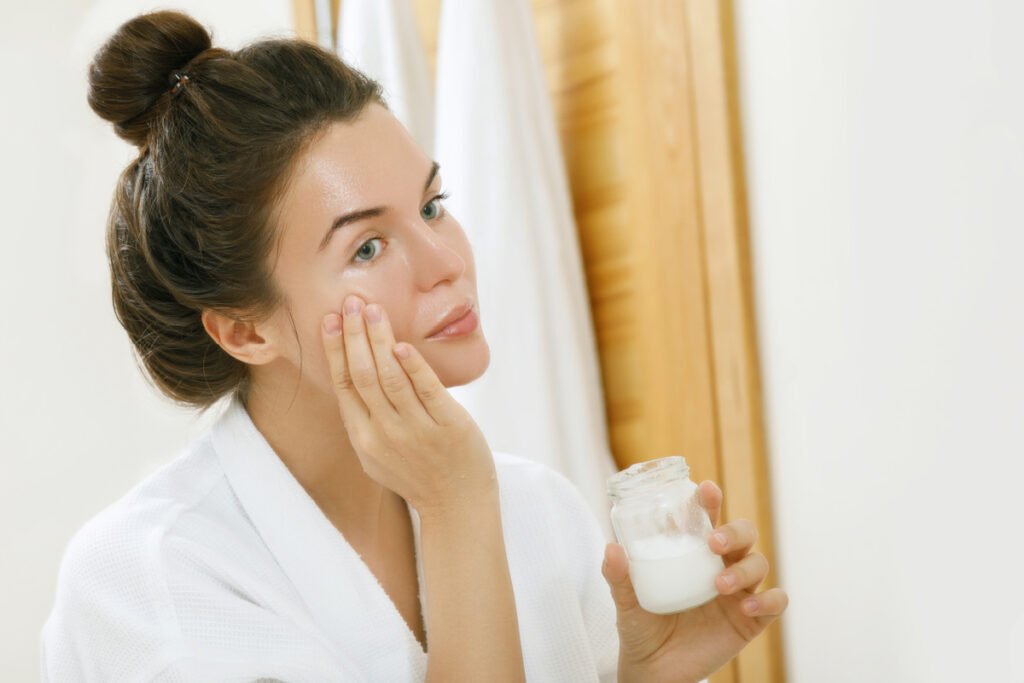Should you be “slugging”? A dermatology PA explains this viral skincare trend

Ever since the skincare trend known as “slugging” went viral on TikTok, celebrities and dermatologists have been touting its benefits for dewy, smooth skin. Yet despite slugging’s popularity, it has left many people wondering if it is a safe and effective facial skincare regimen. With winter approaching, your dry skin may be tempting you to find out if slugging really is the key to achieving hydrated, dewy skin—but before you do, read Dermatology Physician Assistant Stacey J. Spehalski’s answers to your questions about the what, why, who, and when of slugging.
What is slugging?
Slugging is a K-Beauty skincare trend that involves coating your face in an occlusive product overnight in order to trap in moisture. Most people use petrolatum-based ointments such as Vaseline or Aquaphor, but you may substitute a thick balm with a different ingredient base. As you may have imagined, the name “slugging” comes from the slimy look Vaseline gives the face once it’s applied.
What is petrolatum?
Petrolatum, or petroleum jelly as it’s more commonly called, is a mixture of natural mineral oils and waxes used in Vaseline. Petroleum jelly has long been considered safe to use on skin and is cherished by many for its ability to quickly rejuvenate dry skin on the body. (It is most commonly used in areas prone to extremely dry skin, such as the heels, hands, and lips.) It is also non-comedogenic, meaning it won’t clog pores despite its greasy texture.
Who can benefit from slugging?
People with dry or normal skin may benefit from slugging, as well as those with mature skin that has become drier with age. Petroleum jelly can be applied to the entire face or used to spot-treat dry patches of skin on the face, such as the jawline, lips, and eyelids.
Who should avoid slugging?
Those with oily or acne-prone skin should avoid slugging, as it can aggravate acne by trapping oil and bacteria in the skin. If Vaseline is too heavy and greasy for your taste, our Reading dermatology office recommends using a medical-grade moisturizer, like SkinMedica’s Dermal Repair Cream, which is safe for all skin types and contains stable antioxidants, hyaluronic acid, and squalane. As an added benefit, a quality moisturizer won’t stick to your sheets like Vaseline will.
People with oily or acne-prone skin should avoid slugging, as it can aggravate acne by trapping oil and bacteria in your skin.
How often should you slug?
Because slugging is so effective at trapping moisture within the skin, you should only do it 1-2 nights a week; any more than that can affect your skin’s ability to maintain its natural barrier. Nights without an occlusive covering allow your skin to regulate itself naturally. Also, be sure to use a very small amount of petroleum jelly—just enough to create a thin layer over your skin.
Slugging won’t replace your medical-grade skincare routine
While slugging with occlusive products is very effective at holding in moisture, it doesn’t prevent skin aging. Therefore, you’ll still need to use quality, medical-grade skincare products containing ingredients like retinol or vitamin C if you want to keep your skin looking youthful and elastic.
Slugging won’t prevent skin aging, so you’ll still need to use quality, medical-grade skincare products when you are not applying an occlusive.
To target specific concerns like discoloration, acne, or dull skin tone, our aestheticians offer customized facials and peels that can provide a boost and complement your at-home skincare routine. For those with deep lines and/or volume loss, cosmetic fillers like Juvéderm® can help to improve the look and feel of aging skin by boosting collagen production deep within the dermis. Similarly, Botox® can help smooth away fine lines and wrinkles in the upper face, quickly taking years off your appearance.
If you choose to take the next step in restoring a more youthful look with professional facials or cosmetic injections, be sure to choose a qualified professional with extensive experience. Our team of aestheticians and nurse injectors are highly trained with many years of experience achieving gorgeous, natural-looking results.
How to do slugging the right way
If you’re simply applying gobs of Vaseline to your face in hopes of smooth, immaculate skin when you wake up, it’s time to learn how to slug the right way. Here are a few steps to follow before going to sleep to help you get the glow you’re after:
- Wash your skin with a gentle cleanser. It’s key to remove any dirt, sunscreen, or makeup since these could lead to breakouts if trapped under an occlusive.
- Smooth on your moisturizer as you normally would. While slugging holds in moisture, it doesn’t add moisture, so continue to use a hydrating product with ingredients like glycerin and hyaluronic acid.
- Spread a thin layer of petrolatum over your face to lock in moisture overnight. If you are concerned about breakouts, avoid areas of your face that are more acne-prone than others.
- In the morning, use a gentle cleanser to wash your face before starting your normal skincare routine.
Before slugging, skip your medical-grade serums with active ingredients like retinol or exfoliating acids. These can become more intense and potentially irritating when trapped under an occlusive, so we recommend using these on days when you are not slugging.
Remember, slugging should be performed no more than 2 times a week.
Let our Reading dermatology team customize your skincare routine! At Berks Plastic Surgery, our stellar medical spa team offers dermatology services, professional skincare advice, facials, and injectables all under one roof. The practice is led by renowned board certified plastic surgeon Dr. Brian Reedy. We look forward to helping you achieve a healthy, natural glow and prevent skin aging! Schedule your consultation online or give us a call at 610-320-0200.
